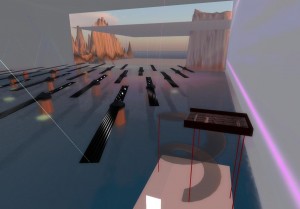Issue 28 11.20.13

Painting Data: When Art Goes Virtual
Oberon Onmura
If we consider an artist as fundamentally an agent of creation, the question then arises “creation of what?” And when the artist is creating within a virtual environment, that “what” begs additional discussion. In my view, an artist takes what is available from the surrounding environment, manipulates it physically or conceptually, and presents the result to an audience. Creation, in this sense, is a sort of “feedback loop” where the artist responds to the environment by adding to it, thus altering it, and then responds to that altered environment, changing it further. The creation process, then, is dynamic, and fully dependent on artists’ ability to “tune in” to the environment they inhabit.
In the physical world, artists have available a wide range of materials to work with – paper, rocks, paint, metal, chalk, clay, etc.. But each material has a limited range of available options for shaping, coloring, or otherwise manipulating that material. The process of creation, then, in the physical world, is largely one of transformation of materials. Paint remains paint before and after it is applied to canvas; the transformation of “paint” to “painting” realigns the material in conformity with the artist’s vision. The result of the artist’s work is (usually) a unique physical object that can be transported, displayed, and purchased. The art product that is ultimately purchased is not the paint, canvas, and wood, but the artist’s transformation of those materials into her notion of art.
By contrast, in a three-dimensional virtual environment, there is no material for the artist to transform. The artist is, in fact, manipulating data into patterns to create new information. Only when that information is instantiated within a virtual environment (requiring an appropriate set of hardware and software) can it take on properties and behaviors that can be manipulated – transformed – by the artist, and ultimately viewed by others. There is no “object” to transport, display, or purchase; there is only data stored in disk drives on servers. Digital information is, by definition, infinitely replicable, and so cannot be thought of as unique in the sense that only one exists in the world. What is unique, instead, is the artist’s ability to organize patterns of data in such a way that they are recognizable as the work of – and only of – that artist. What the artist can sell, then, is access to those unique information patterns, and, by extension, to the hardware/software systems required to instantiate the information.
While this mode of artmaking (and hopefully art marketing) may seem conceptual almost to the point of being unfeasible, the fact is we are accustomed to using – even purchasing – unique patterns of data that are unattached to and not representing any physical object. A perfect example is downloading an ebook into an ebook reader. The “book” we are purchasing is, in fact, a set of unique patterns of data designed to be instantiated into alphanumeric characters by the reader. There is no need to purchase a physical “book object” in order to gain access to its information (and there is no reason to create one in the first place). We only need to purchase the data patterns themselves as long as we have a way to translate that data into characters we can parse in order to gain meaning from them. The owner of the data is selling access to the data; the result for the buyer is the ability to read the patterns of information in the ebook reader.
In pointing out this fundamental distinction between physical and virtual art, it is not to make a case that privileges one above the other, but to introduce the concept of virtuality as defined by N. Katherine Hayles in her book “How We Became Posthuman: Virtual Bodies in Cybernetics,Literature, and Informatics.” (University of Chicago Press, 1999) Hayles defines virtuality as “a cultural mindset … perceiving information as more mobile, more important, more essential than material forms [emphasis the author’s]. Artists working in threedimensional virtual environments represent the essence of virtuality, since they create and manipulate information rather than materials in a purely conceptual art practice.
Once the connection to material objects is removed from the creation of artworks and replaced with manipulation of patterns of information, what then is a reasonable basis for assessing the monetary value of the resulting products? Viewers of the work cannot directly see the data that creates the work, and would not see meaning in that data even if it were possible. And since digital data is infinitely perfectly reproducible, the previously ironclad law of supply and demand fails, as well. So what can we use as a reliable metric for asserting that some work is good and some is better?
One answer to these questions – and unfortunately not a good one – is that it is too soon to tell because there is, at present, no market for three-dimensional virtual art outside the virtual spaces themselves. And not much of a market within those spaces, either, I’m afraid. When a market does arise, the market itself will begin to find ways to assign value to virtual artworks. This will require a new kind of critical dialog, a new way of discussing art, and a new set of cultural touchstones that help us understand an art form that is “more mobile, more important, more essential than material forms.”
